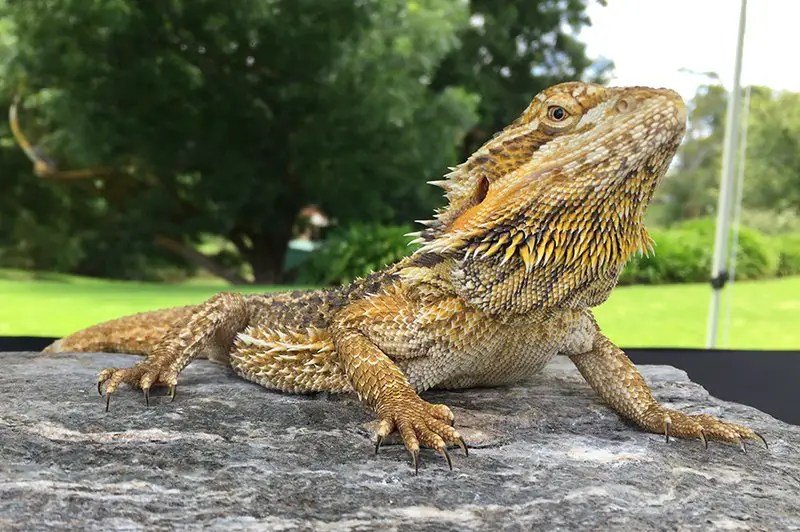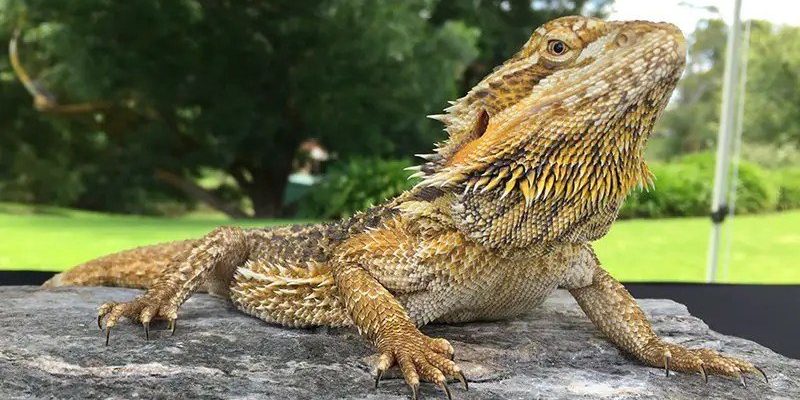
In this article, we’ll dive into the specific adaptations that equip the bearded dragon to be a true survivor. Think of them as special superhero powers that help these lizards navigate their world. From their skin texture to their diet and social behavior, bearded dragons have all sorts of tricks up their sleeves. So, grab your favorite beverage, and let’s explore what makes these remarkable reptiles tick.
1. Desert Camouflage: Blending Into the Environment
One of the standout adaptations of the bearded dragon is its ability to blend into its surroundings. Their skin features a range of colors, from sandy browns to earthy yellows, allowing them to hide among rocks and foliage. This natural camouflage helps them evade predators, making them harder to spot in the wild.
But it’s not just about hiding from danger. When basking in the sun, bearded dragons can change their skin color slightly, which helps them regulate their body temperature. You might be wondering how effective this is. Imagine wearing a tan outfit at the beach to blend in with the sand. Similarly, the bearded dragon’s color shifts help it absorb heat more efficiently, keeping it warm and cozy during chilly nights.
This ability to camouflage not only protects them from threats but also aids in hunting. A well-camouflaged bearded dragon can ambush unsuspecting prey like insects, ensuring a steady food supply. It’s like being a ninja in the desert, stealthily waiting for the right moment to strike!
2. Efficient Thermoregulation: Mastering the Sun
Living in the hot deserts of Australia means bearded dragons face extreme temperatures. They have evolved remarkable methods for thermoregulation, or maintaining their body temperature. During the day, they bask in the sun to warm up. However, when it gets too hot, they know just when to seek shade or burrow into the cool ground.
Here’s the thing: bearded dragons are ectothermic, meaning they rely on external sources of heat. When the sun shines brightly, they can often be found soaking up rays, which helps them digest food and stay energized. But, if temperatures soar, they have the smarts to retreat to cooler areas, similar to how you might seek shade under a tree on a hot day.
This clever temperature management ensures they remain active and healthy. It’s not just about survival; it’s about thriving in a tough environment. Adaptations like this show how well-suited bearded dragons are to their habitat, allowing them to live full lives, even when the weather gets extreme.
3. Unique Feeding Habits: An Omnivorous Diet
When it comes to food, bearded dragons are omnivores, which means they eat a variety of things. Their diet typically includes insects, plants, and even fruits. This flexibility allows them to adapt to whatever their environment offers. Imagine going to a buffet where you can choose anything you want—that’s how bearded dragons approach their meals!
In the wild, they’ll munch on crickets, mealworms, and leafy greens. But did you know that their feeding habits change based on their age? Young dragons often eat more protein, like bugs, to support their growth, while adults may consume more veggies. This shift helps them get the right nutrients at different life stages.
Being omnivorous not only offers a diverse diet but also means that they can thrive in areas where food might not be plentiful. If one food source becomes scarce, they can easily switch to another, making it easier for them to survive in unpredictable environments.
4. Social Behavior: Communication and Hierarchy
Bearded dragons aren’t just lone wolves; they have interesting social structures that contribute to their survival. They communicate through body language and displays, such as head bobbing and arm waving. For example, a bearded dragon might puff up its throat and bob its head to show dominance or assert territory.
This social behavior is crucial, especially when competing for resources like food or basking spots. Imagine being at a crowded park trying to claim a sunny patch of grass. The bearded dragon’s lively social signals help establish a clear hierarchy within their group, reducing conflicts and ensuring everyone knows their place.
Interestingly, social interactions can affect their health too. According to studies, bearded dragons that interact regularly with others tend to be healthier and happier. This sense of community can contribute to their well-being, providing reassurance in their sometimes harsh environments.
5. Resilience Against Predators
Predators are a constant threat in the wild, but bearded dragons have developed several strategies to protect themselves. Aside from their impressive camouflage, these lizards have an arsenal of defensive tactics. One of the most notable is their ability to puff up, making themselves appear larger and more intimidating.
In stressful situations, they might also drop their tails as a distraction to escape while the predator is confused. It’s a bit like a magician’s trick: the tail keeps the attention while they make a quick getaway. While regrowing a tail can take time, this adaptation is a smart survival tactic that can save their lives.
Their resilience doesn’t stop there. Bearded dragons also have sharp claws and strong jaws, which they use to defend against threats if needed. So, while they might look cute lounging in your living room, they’re equipped with the skills to handle their own in the wild.
6. Reproduction: Strategy for Survival
Survival isn’t just about the individual; it also extends to the next generation. Bearded dragons have specific reproductive strategies to ensure their lineage continues. They can lay dozens of eggs at once, which might seem risky, but it’s a smart move. The more eggs they lay, the higher the chances that some will survive despite environmental challenges or predators.
Here’s another fun fact: female bearded dragons can store sperm for several months. This means they can lay multiple clutches of eggs from a single mating. Imagine having the ability to plan for your future offspring without having to find a mate every time! This adaptation not only maximizes the chances of reproduction but also ensures that their genetic traits are passed on.
Once the eggs are laid, the baby dragons, or hatchlings, are immediately independent. They are born ready to fend for themselves, which is crucial in a world where every meal and every moment can be a challenge.
7. Adaptability to Habitat: Thriving in Diverse Environments
Finally, perhaps one of the most impressive adaptations of the bearded dragon is its ability to thrive in diverse habitats. While they are native to the dry forests, scrublands, and deserts of Australia, they can adapt to varying conditions. This adaptability allows them to survive in different climates and terrains.
You might find them in rocky areas, underbrush, or even near human settlements. Their ability to adjust their behavior based on their surroundings speaks to their resilience. For instance, in more populated areas, they might become bolder, venturing closer to human habitats for food while still being cautious of predators.
This capacity to adapt not only enhances their chances of survival but also makes them a fascinating subject of study for scientists looking to understand how species evolve in response to changing environments.
So there you have it—the bearded dragon is a true survivor, equipped with a range of remarkable adaptations. From their stunning camouflage and unique feeding habits to their social structures and resilience against predators, each feature plays a vital role in their survival.
Honestly, it’s impressive how these lizards navigate the challenges of their environments, making them both fascinating pets and inspiring examples of nature’s ingenuity. If you ever find yourself watching your bearded dragon bask in the sun or scouring its tank, take a moment to appreciate the incredible adaptations that allow it to thrive in a harsh world. It’s a little reminder of the wonders of evolution and survival.

